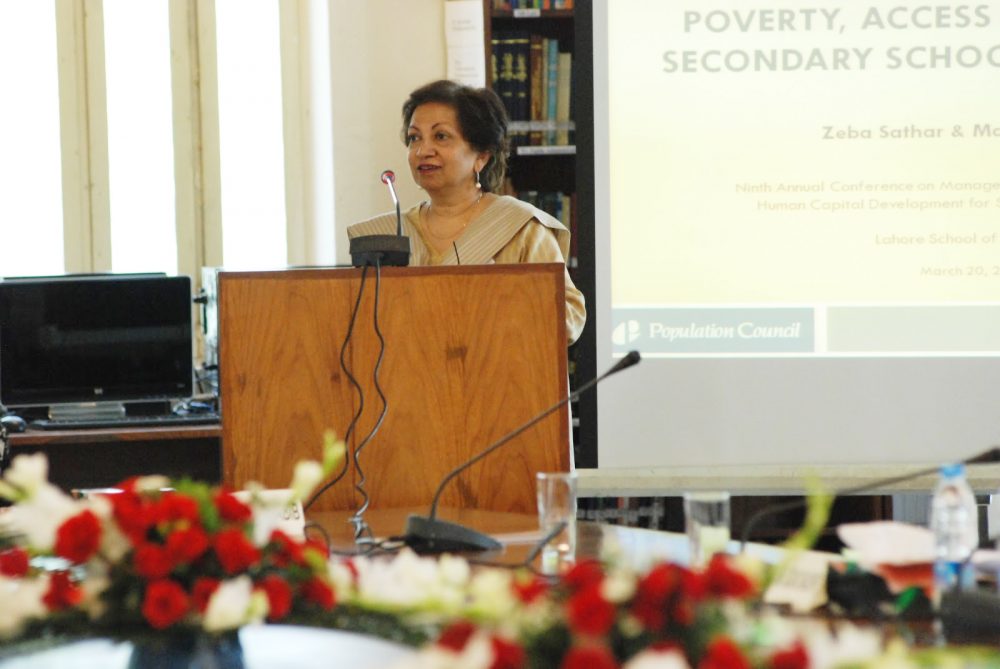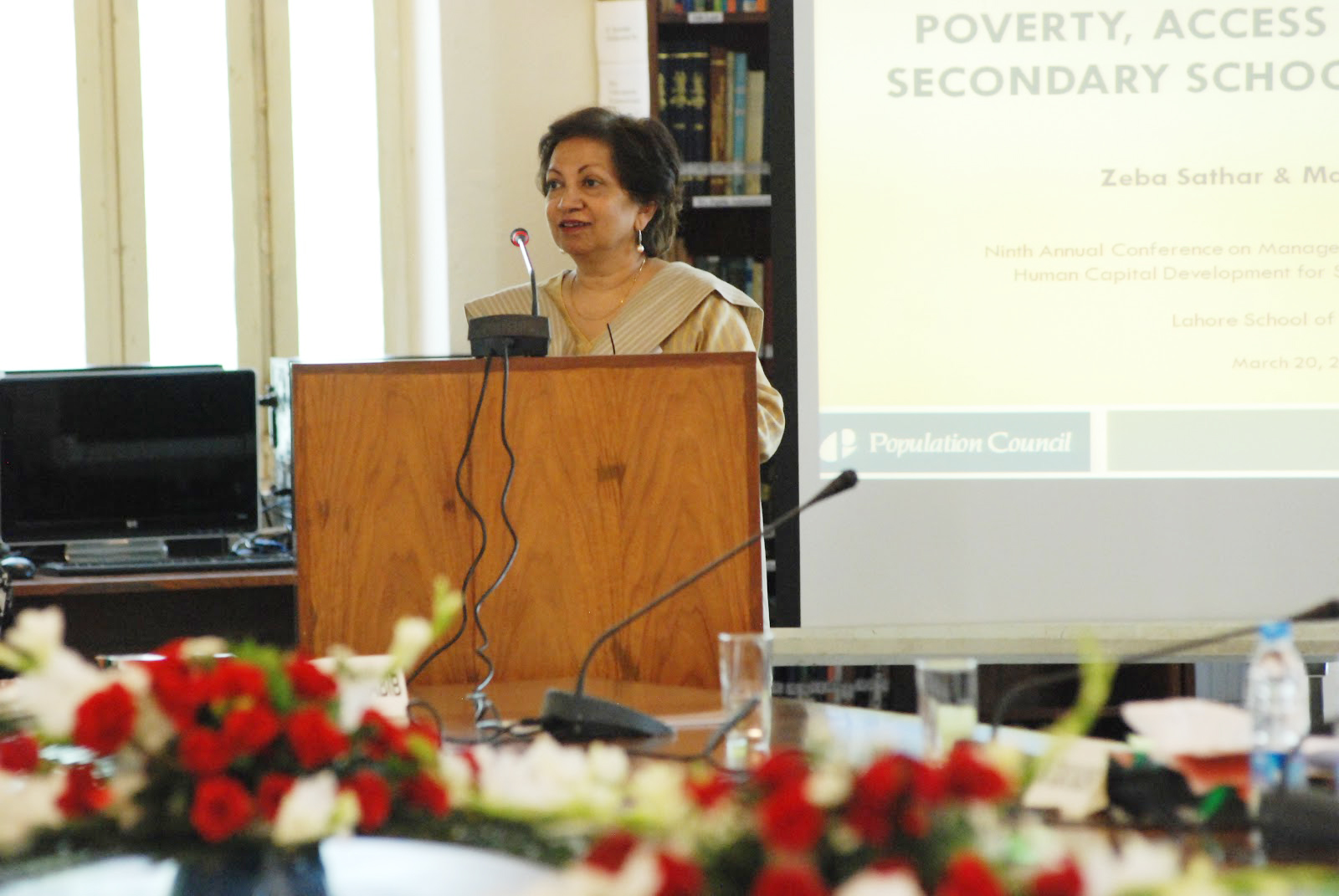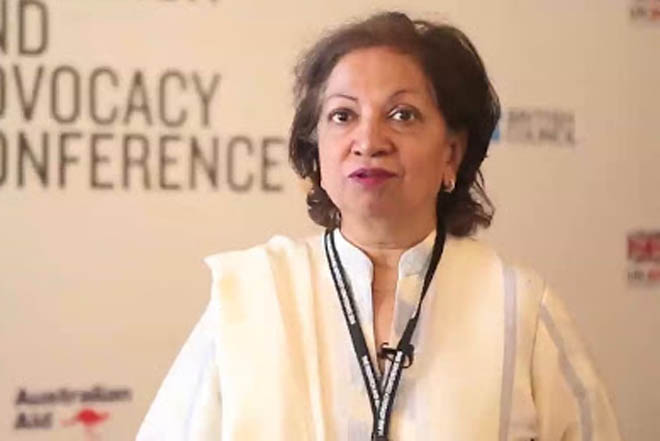“The peak population growth may be over but the momentum continues” – Zeba Sathar
By Afsheen Ahmed | Special Report | Published 8 years ago
Zeba Sathar is a senior associate and country director of the Population Council’s office in Islamabad, Pakistan, overseeing technical assistance and capacity building, social science research, and population and demographic dividend research that informs national policy discussions and developments. Sathar also represents the Council through advisory meetings with government officials in Pakistan. Her expertise includes cross-national comparative research, advocacy for policy change, analysis of demographic trends and patterns, and evaluations of health service delivery systems. She is a member of the Governing Council of the Pakistan Bureau of Statistics, responsible for the current census. Prior to joining the Council, Sathar was chief of research and demography at the Pakistan Institute of Development Economics (PIDE) and a population consultant with the World Bank in Islamabad.
She is the first Pakistani to be elected to the governing council of the International Union for the Scientific Study of Population, and is a co-lead of FP2020’s Performance, Monitoring and Accountability working group (the latter an outcome of the 2012 London Summit on Family Planning). A thorough professional, despite her very hectic schedule, she gave Newsline the interview at short notice.
Which ministry is primarily responsible for the census and its implementation? How inclusive was the process, in terms of taking all stakeholders on board?
The Ministry of Finance, Economic Affairs and Statistics is responsible for the census. The independently established Pakistan Bureau of Statistics (PBS), working under the umbrella of this ministry, is the one actually implementing the census. Unfortunately, the census preparations have not been very thorough or inclusive. The advice of experts and those involved in previous census activities were not sought. As a member of the Governing Council of the PBS, I happened to be included in consultations about the census. But unlike the 1998 census, the regular set of advisory board meetings were not held. These meetings would have helped guide the PBS to avoid some expected pitfalls. The last major meeting of the Census Advisory Board was held in 2008.
On the other hand, in the run-up to the census, there has been more interaction between the PBS and the media and Standing Committees of the Senate etc. So the PBS has been more responsive to these requests.
The census seems to have become controversial from the first visit. Starting with protests about special groups being left out — like the transgenders, special religious groups like the Sikhs, the Bahais, the Parsis and those with disabilities. Were these groups included in the 1998 census?
I don’t think that the census is controversial for those reasons. The census has become politicised because the results will affect the shares of the National Finance Commission (NFC) financial transfers to the provinces and political seat allocations. But as far as the transgender population is concerned, the PBS actually tried to include them in the column under sex; they have been given code 3. Code 1 is for males and 2 for females. As far as the religious groups like the Sikhs, the Bahais, and the Parsis are concerned, they could have been included by adding additional codes. The PBS decided to stick with the status quo and not include additional codes. They were left out of the 1998 census as well. Collecting accurate data on disability requires a few additional questions; it cannot be done purely on the basis of observation or reporting. The current plan to accommodate disability status in the sex column, is a very ad hoc solution.
Starting with the first census in 1951, how much of a rise has been registered in the population graph, and what percentage has it gone up by, census after census, even after losing half the country in 1971? Do you foresee a dramatic demographic change in the census being held after 19 years?
This (Table 1) is roughly what the population graph looks like. We have grown from 34 million to 132 million between 1951 and 1998. (The population of the then East Pakistan is not included). That is an addition of a 100 million people in 47 years. The peak population growth may be over but the momentum continues. The real spurt in population growth started in the ’70s with declines in mortality. Between 1981 and 1998, we did see a decline in intercensal population growth rates and similarly we are expecting a further decline in the intercensal population growth rates between 1998 and 2017 to about 2.1. But the problem is the large base that we already have and the built-in population momentum.
Undoubtedly, there will be a lot of changes in the 2017 census, especially in age structure and in spatial distribution. The dramatic change is that we are close to the 200 million mark when we were 84 million in 1981. But perhaps the shock value may be over, since a figure of 200 million has already been talked about and widely accepted.
There is a lot of noise that the Afghans will be counted as Pashtuns. In Karachi, in Balochistan, this may change the ethnic make-up. Is there any in-built mechanism in the process to check for this?
There is bound to be a change in the ethnic complexion. But the counting should not discriminate on the basis of ethnicity. The basic premise is that anyone who has lived here since the last six months will be counted, regardless of nationality. However, the nationality of self-declared Afghans will be recorded. They may be asked if they are Pakistanis or not. This information should appear at the data analysis stage where there may be a classification of those that reported themselves as non-Pakistanis.
Have enumerators been gender-sensitised during trainings? For example, there are now many female-headed households, yet they keep asking for a male head of household.
In this respect I think the enumerators were more gender-sensitised in 1998. There was a lot of emphasis on gender, female enumerators, and training of trainers to include females in the count and to record female heads of households. We did not see the same emphasis on gender sensitisation in this census. In fact there is concern that there are hardly any female enumerators. It is alarming to hear accounts that enumerators are assuming that the head of a household has to be male and keep insisting on recording only men as heads.

There are nearly six million Pakistanis abroad. Why have they been left out. Couldn’t there have been a mechanism to include them?
This census is being conducted on a de-jure basis. Anyone who usually lives in Pakistan has to be counted, within a six-month reference period. Form 2 also records numbers of members who are living abroad, but that is not the purpose of the census. We need a count of how many are living in Pakistan in 2017 as the priority. The numbers living abroad ought to be compiled separately.
How much of an input did the Population Council provide in preparing the census form? Was there any pretesting, any pilot carried out?
Unfortunately, no strong pre-test has been conducted. The rationale put forward was that since the questionnaire is similar to the one used in 1998, hence no pilot was required. I think this is a huge mistake, since even smaller surveys require pilot testing of procedures and content of questionnaires.
The questionnaire was finalised and printed more than eight years ago in preparation of the 2008 census. (The Population Council did not provide any inputs in the Form).
Now that the household counting has begun and is taking longer than expected, what is the feedback from the field? Is the schedule flexible enough to allow for extensions in timelines?
The household listing should just involve a marking of household structures. It is Form 2 that establishes household characteristics and individual member characteristics. Unlike the 1998 census, there is a lot of emphasis on CNIC cards and recording of card numbers, but frankly that is very time-consuming. The “short” form is in fact more like a long form, and yet it is missing some important characteristics like recording disability properly.
Having said that, we have not heard of any official extensions in the scheduling of the census. There is some flexibility built in, but if an enumerator feels during the rounds that he/she will be unable to complete the work in the block, they are supposed to inform the circle supervisor and an additional enumerator may be deputed with them. There are also additional days set aside for counting homeless people that can be used for “catching up” with the count.
What kind of information is being solicited? At one level, it is supposed to be a straightforward headcount and house count. But there is apparently a range of questions being asked about the general living conditions. Eventually, what sort of information do you hope to extract from this census? How will it be used?
While we are all concerned about the quality of the data that is being collected in the census, there is no disagreement that the census is vital for all essential planning. The census will provide the actual count that surveys only estimate, of how many we are, where we live and under what conditions. This will include information about the kind of construction, sources of water, electricity and toilet facilities available. This information is essential for planning for housing, making poverty assessments, etc.
How many spoken languages have been included in the form?
There are nine languages that have been included in the questionnaire. These are Urdu, Punjabi, Sindhi, Pashto, Balochi, Kashmiri, Seraiki, Hindko and Brahui. All other languages will be recorded as “other.” Of course as in the case of other shortcomings, if the PBS had redesigned the (2008) questionnaire or consulted on its contents, then more languages could have been included.
Who is doing the collating? Is the Population Council involved in this process?
This is purely the PBS’s responsibility. Once the forms are filled, they will be sent to Islamabad under special security and processed there.
Are the number of enumerators — 84,000 — enough? Have you got any feedback on what issues they are encountering in the field? How many visits to one household are required/budgeted for, to collect the needed information?
The numbers of enumerators are based on the number of blocks formed. Each enumerator will complete the count in two blocks. I do not have detailed feedback at this point.
With reference to Karachi, supposedly there are 2.5 million Bengalis in Karachi alone who opted to stay on after 1971 and are therefore Pakistanis. Why are they being labelled as ‘legal’ and not just as Pakistanis, since most have been born and brought up here and have ID cards. Why are they being slotted in a separate category?
Bengali is not recorded as a mother tongue, or as a nationality in any column. Theoretically, everyone residing in the same household for the last six months should be included. They should not be in a different category.
How will the Biharis who opted to leave East Pakistan and come to Pakistan be categorised?
They should definitely be counted as Pakistanis.
Do you see the results showing a dramatic shift in the rural-urban break-up?
The proportion, compared to the 1998 census, will definitely change. Form 2 does not provide details of migration or place of origin, but Form 2A is expected to do this on a sample basis. Regardless, we will see differences in the urban-rural break-up. And especially in the size of the major cities and towns.

The 1998 census showed the majority (63 per cent) to be under 25 years. Is that likely to change?
I think the most dramatic change is going to be in age structures (Table 2). In 1998 there were 43 per cent below 15 years (58 million) and while it is estimated that there are now 12 million more children under 15, they represent 35 per cent of the population. The under-25 population was 63 per cent in 1998, it is estimated to have declined to 55 per cent. In comparison however, the working age population is estimated to have increased from 53 per cent to 61 per cent — from 70 to 121 million! All good. This means there is a potential opportunity of lower dependency ratios and a demographic dividend opportunity, provided the economy can provide 50 million additional job opportunities.
Karachi, for example, will probably show a huge increase in numbers. How much of that is likely to be natural increase and how much is due to migration from rural areas, other provinces etc.?
It is really difficult to answer that question until we see the results. And as I said earlier, migration will be covered in the long Form 2A to come later. But even after Form 2, we will definitely begin to see the trends of how much of Karachi’s growth is natural and the part due to migration.
Politicians are insisting that the data of the headcount and the house count must be shared with political forces immediately after completion of the process in each district. Is this possible?
I think sharing results just after the data collection would prove to be difficult. Firstly, the information is confidential at the household level and needs to be compiled from the block level to the district level. The retrieval of the REN — 2 (cover sheet of census book/s filled in block) will be the first step. If the count based on just the REN-2 are shared at that stage, it is likely to be tentative and lead to chaos. It is conceivable that the results could be shared after they have been cross-verified with at least a sample of the individual forms, district by district. After this cross-verification, on a sample basis, the PBS may begin to share preliminary results even at the provincial level. A fuller and more accurate count can only be shared when all individual forms have been entered — this will take more than three or four months after the data collection.
Some politicians are apprehensive of the government’s intention to take the results to Islamabad and keep them secret for months. They allege that the data could be manipulated. What is the basis of this fear and how can this issue be resolved?
The fear is unfounded. There are built-in checks to see that the data entry process is transparent. Having said that, I think the PBS needs to do more to build this confidence by allowing observers understand the processing and share as much as possible about its procedures.



